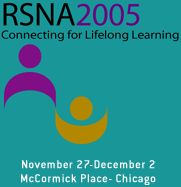
Abstract Archives of the RSNA, 2005
Axel Gossmann MD, Presenter: Nothing to Disclose
Christopher Bangard MD, Abstract Co-Author: Nothing to Disclose
Koert Bloemers, Abstract Co-Author: Nothing to Disclose
Clemens Bos PHD, Abstract Co-Author: Nothing to Disclose
Eleni Siakavara MD, Abstract Co-Author: Nothing to Disclose
Klaus Lackner MD, Abstract Co-Author: Nothing to Disclose
The aim of our study was to generate flexion and extension MR images of the lumbar spine with high spatial resolution using an open high field MR scanner.
The lumbar spines of ten volunteers were examined on an open high field MR scanner (Panorama 1.0T, Philips Medical Systems, Eindhoven, The Netherlands). Sagittal high spatial resolution T2-weighted (w) and T1-w turbo-spin-echo (TSE) sequences as well as a xial T2-w TSE sequences of the lumbar spine were performed with the spine in maximal flexion, neutral position, and in maximal extension. Images were analyzed by two experienced radiologists for different clinically relevant anatomical structures (vertebr al bodies and discs, dural tube, nerve roots, facet joints, ligamenta flava, potential displacement of vertebral bodies).›
High spatial resolution MR images of the spine in neutral position as well as in flexion and extension yielded an excellent image quality (low SNR) with good delineation of clinically relevant anatomical structures. Even small structures, such as intradural roots, could be clearly demonstrated. Due to imaging in flexion and extension positions, a potential displacement of the vertebral bodies and disc bulges could be assessed comparable to lateral myelograms.9
High spatial resolution MR images of the lumbar spine in flexion and extension using an open high field MR scanner allow a clear delineation of small anatomical structures. Due to the capability of assessing the displacement of vertebral bodies and disc bulges, high spatial resolution MR imaging in flexion and extension might be as diagnostic as lateral myelograms in combination with CT-myelograms.
K.B.,C.B.: Koert Bloemers and Clemens Bos are working for Philips Medical Systems
Gossmann, A,
Bangard, C,
Bloemers, K,
Bos, C,
Siakavara, E,
Lackner, K,
Flexion and Extension MR Examinations of the Lumbar Spine Using a 1.0 Tesla Open MR System. Radiological Society of North America 2005 Scientific Assembly and Annual Meeting, November 27 - December 2, 2005 ,Chicago IL.
http://archive.rsna.org/2005/4417445.html

